Abstract
The mechanisms and kinetics of the immunosuppressive effects of alternate-day prednisone were investigated in a group of patients with a variety of inflammatory diseases receiving a range of alternate-day prednisone doses from 5 to 120 mg. Total circulating lymphocyte and monocyte counts, as well as proportions of lymphocyte subpopulations defined both by surface markers and by in vitro functional capacities, were studied. At 8 a. m. of the day on prednisone, just before drug administration, lymphocyte and monocyte counts, proportions of lymphocyte subpopulations, as well as in vitro lymphocyte blastogenic responses to various mitogenic and antigenic stimuli were normal. 4 h after the administration of prednisone, there was a profound lymphocytopenia and monocytopenia, with a differential depletion of thymus-derived lymphocytes as well as various functionally defined lymphocyte subpopulations. Lymphocyte kinetic studies using a radioactive chromium-labeled autologous lymphocytes showed that the lymphocytopenia was due predominantly to a transient depletion of the recirculating portion of the intravascular lymphocytepool. All these parameters returned to normal by 8 a.m. of the following day (off prednisone) and remained normal throughout the day. This very transient lymphocytopenia and monocytopenia after prednisone, with normal cell numbers, proportions, and functions throughout the remainder of the 2-day cycle, was associated with suppression of disease activity, yet did not affect cutaneous delayed hypersensitivity in these patients nor increase the likelihood of infectious complications. This drug-associated cyclic and transient monocytopenia and selective lymphocytopenia is best explained by a redistribution of recirculating lymphocytes to other body compartments, particularly the bone marrow.
Full text
PDF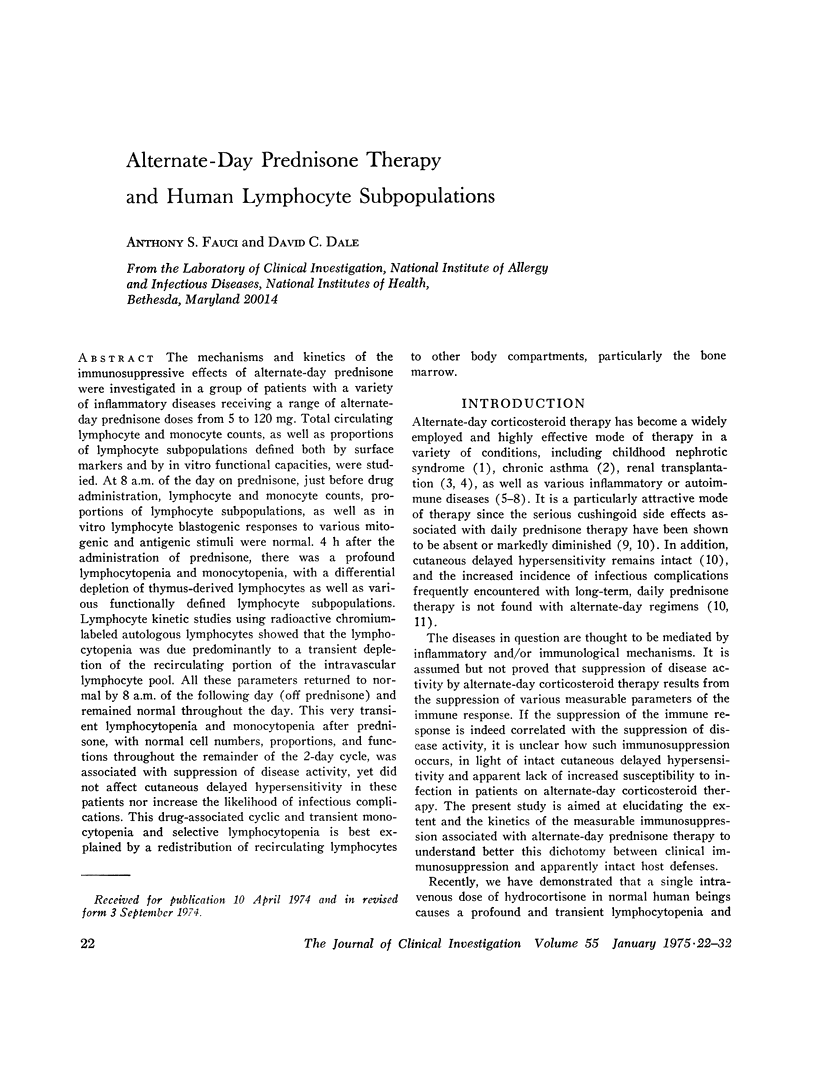
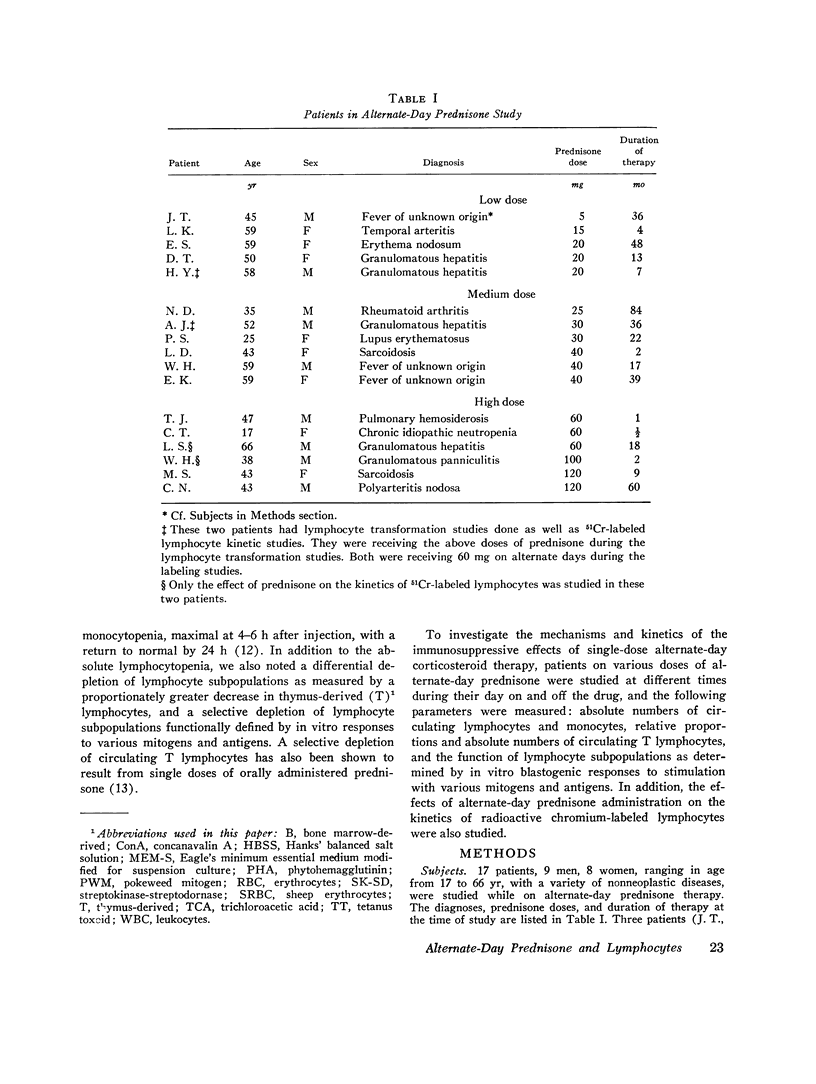
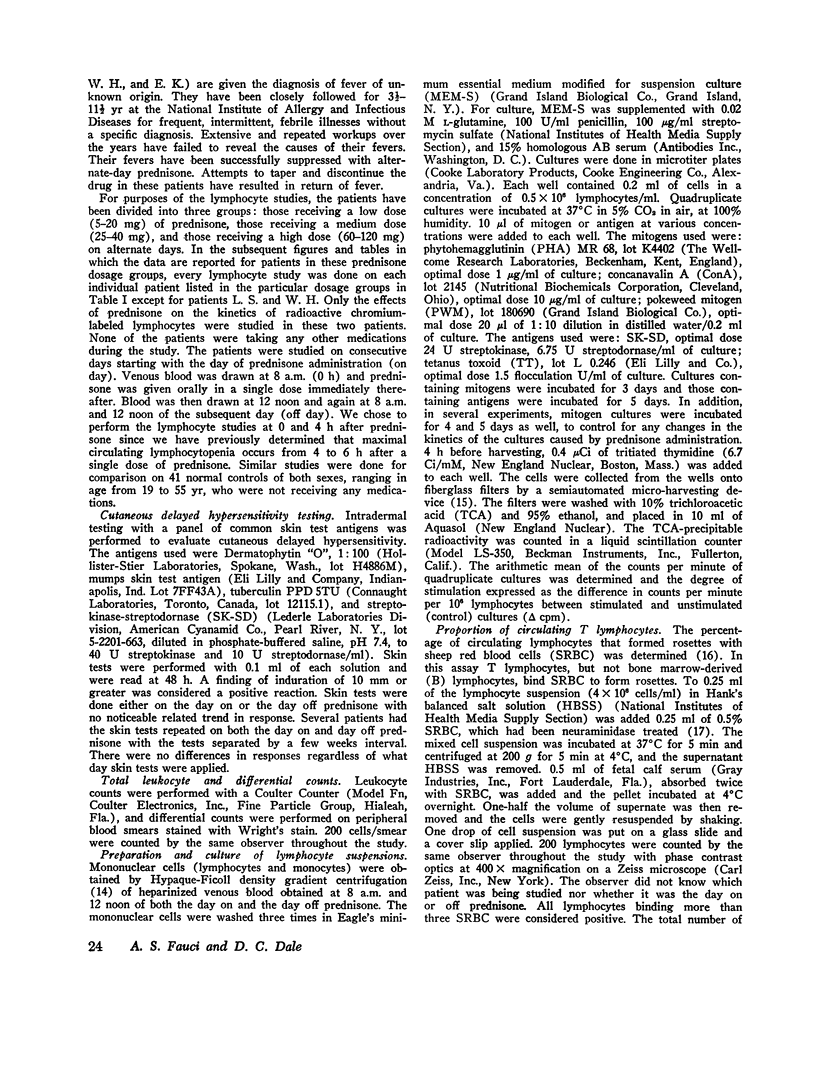
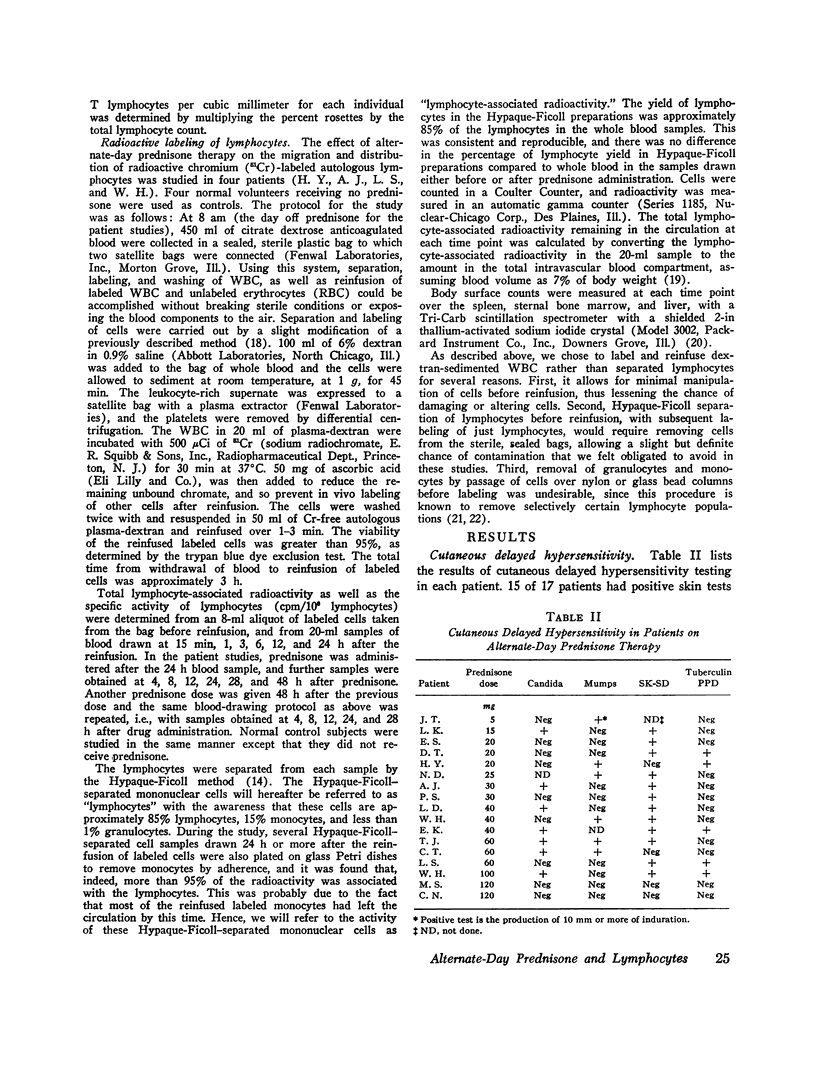

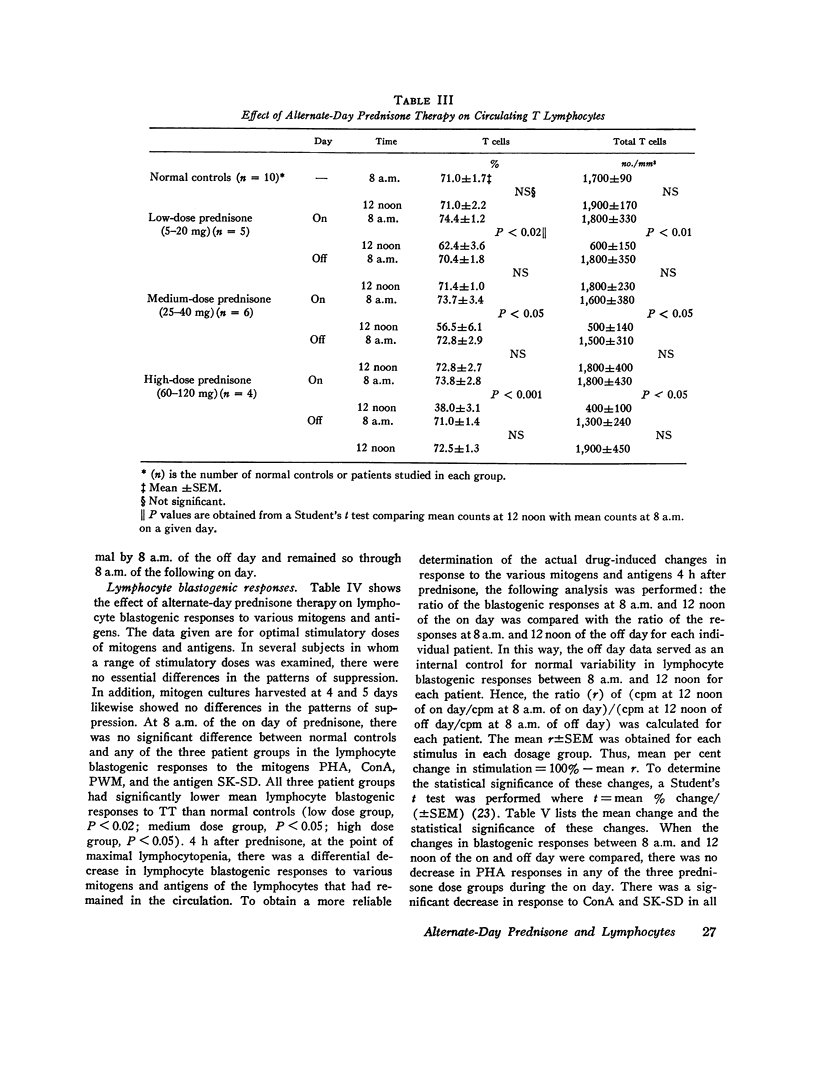




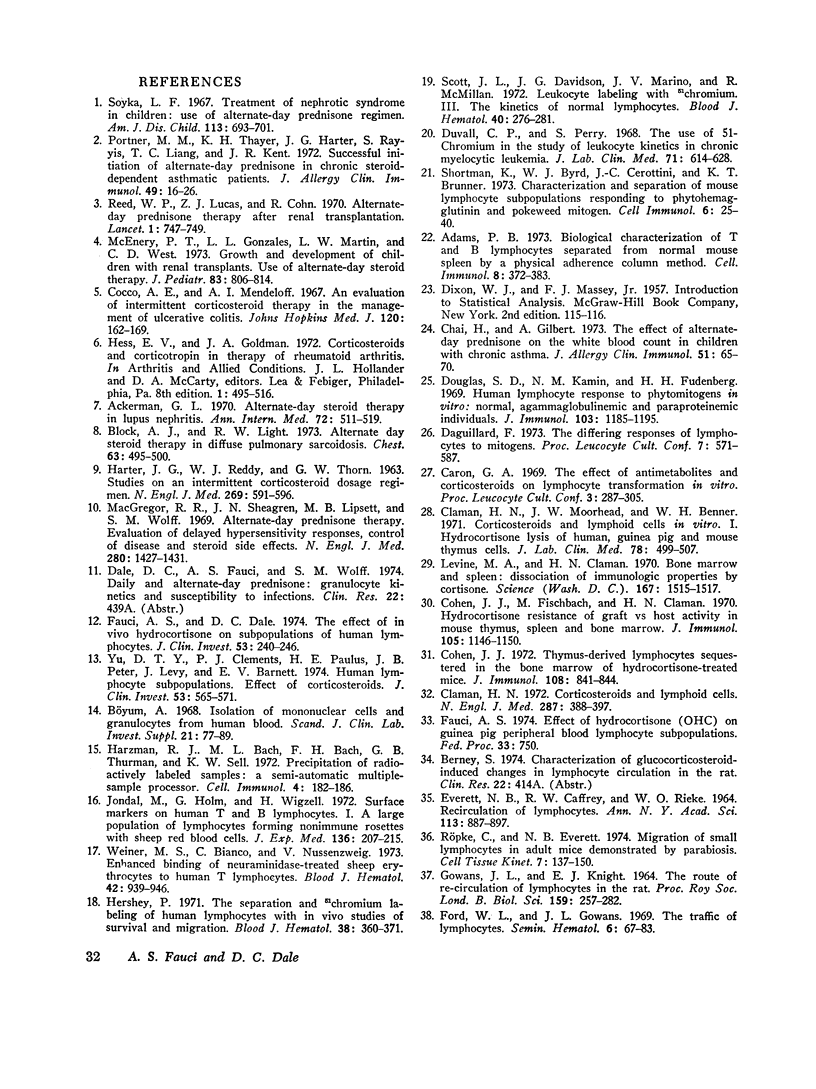
Selected References
These references are in PubMed. This may not be the complete list of references from this article.
- Ackerman G. L. Alternate-day steroid therapy in lupus nephritis. Ann Intern Med. 1970 Apr;72(4):511–519. doi: 10.7326/0003-4819-72-4-511. [DOI] [PubMed] [Google Scholar]
- Adams P. B. Biological characterization of T and B lymphocytes separated from normal mouse spleen by a physical adherence column method. Cell Immunol. 1973 Sep;8(3):372–383. doi: 10.1016/0008-8749(73)90127-5. [DOI] [PubMed] [Google Scholar]
- Block A. J., Light R. W. Alternate day steroid therapy in diffuse pulmonary sarcoidosis. Chest. 1973 Apr;63(4):495–504. doi: 10.1378/chest.63.4.495. [DOI] [PubMed] [Google Scholar]
- Chai H., Gilbert A. The effect of alternate-day prednisone on the white blood count in children with chronic asthma. J Allergy Clin Immunol. 1973 Feb;51(2):65–70. doi: 10.1016/s0091-6749(73)80001-6. [DOI] [PubMed] [Google Scholar]
- Claman H. N. Corticosteroids and lymphoid cells. N Engl J Med. 1972 Aug 24;287(8):388–397. doi: 10.1056/NEJM197208242870806. [DOI] [PubMed] [Google Scholar]
- Claman H. N., Moorhead J. W., Benner W. H. Corticosteroids and lymphoid cells in vitro. I. Hydrocortisone lysis of human, guinea pig, and mouse thymus cells. J Lab Clin Med. 1971 Oct;78(4):499–507. [PubMed] [Google Scholar]
- Cocco A. E., Mendeloff A. I. An evaluation of intermittent corticosteroid therapy in the management of ulcerative colitis. Johns Hopkins Med J. 1967 Mar;120(3):162–169. [PubMed] [Google Scholar]
- Cohen J. J., Fschbach M., Claman H. N. Hydrocortisne resistance of graft vs host activity in mouse thymus, spleen and bone marrow. J Immunol. 1970 Nov;105(5):1146–1150. [PubMed] [Google Scholar]
- Cohen J. J. Thymus-derived lymphocytes sequestered in the bone marrow of hydrocortisone-treated mice. J Immunol. 1972 Mar;108(3):841–844. [PubMed] [Google Scholar]
- Douglas S. D., Kamin R. M., Fudenberg H. H. Human lymphocyte response to phytomitogens in vitro: normal, agammaglobulinemic and paraproteinemic individuals. J Immunol. 1969 Dec;103(6):1185–1195. [PubMed] [Google Scholar]
- Duvall C. P., Perry S. The use of 51-chromium in the study of leukocyte kinetics in chronic myelocytic leukemia. J Lab Clin Med. 1968 Apr;71(4):614–628. [PubMed] [Google Scholar]
- EVERETT N. B., CAFFREY R. W., RIEKE W. O. RECIRCULATION OF LYMPHOCYTES. Ann N Y Acad Sci. 1964 Feb 28;113:887–897. doi: 10.1111/j.1749-6632.1964.tb40710.x. [DOI] [PubMed] [Google Scholar]
- Fauci A. S., Dale D. C. The effect of in vivo hydrocortisone on subpopulations of human lymphocytes. J Clin Invest. 1974 Jan;53(1):240–246. doi: 10.1172/JCI107544. [DOI] [PMC free article] [PubMed] [Google Scholar]
- Ford W. L., Gowans J. L. The traffic of lymphocytes. Semin Hematol. 1969 Jan;6(1):67–83. [PubMed] [Google Scholar]
- GOWANS J. L., KNIGHT E. J. THE ROUTE OF RE-CIRCULATION OF LYMPHOCYTES IN THE RAT. Proc R Soc Lond B Biol Sci. 1964 Jan 14;159:257–282. doi: 10.1098/rspb.1964.0001. [DOI] [PubMed] [Google Scholar]
- HARTER J. G., REDDY W. J., THORN G. W. STUDIES ON AN INTERMITTENT CORTICOSTEROID DOSAGE REGIMEN. N Engl J Med. 1963 Sep 19;269:591–596. doi: 10.1056/NEJM196309192691201. [DOI] [PubMed] [Google Scholar]
- Hartzman R. J., Bach M. L., Bach F. H., Thurman G. B., Sell K. W. Precipitation of radioactively labeled samples: a semi-automatic multiple-sample processor. Cell Immunol. 1972 Jun;4(2):182–186. doi: 10.1016/0008-8749(72)90018-4. [DOI] [PubMed] [Google Scholar]
- Jondal M., Holm G., Wigzell H. Surface markers on human T and B lymphocytes. I. A large population of lymphocytes forming nonimmune rosettes with sheep red blood cells. J Exp Med. 1972 Aug 1;136(2):207–215. doi: 10.1084/jem.136.2.207. [DOI] [PMC free article] [PubMed] [Google Scholar]
- Levine M. A., Claman H. N. Bone marrow and spleen: dissociation of immunologic properties by cortisone. Science. 1970 Mar 13;167(3924):1515–1517. doi: 10.1126/science.167.3924.1515. [DOI] [PubMed] [Google Scholar]
- MacGregor R. R., Sheagren J. N., Lipsett M. B., Wolff S. M. Alternate-day prednisone therapy. Evaluation of delayed hypersensitivity responses, control of disease and steroid side effects. N Engl J Med. 1969 Jun 26;280(26):1427–1431. doi: 10.1056/NEJM196906262802601. [DOI] [PubMed] [Google Scholar]
- McEnery P. T., Gonzalez L. L., Martin L. W., West C. D. Growth and development of children with renal transplants. Use of alternate-day steroid therapy. J Pediatr. 1973 Nov;83(5):806–814. doi: 10.1016/s0022-3476(73)80373-7. [DOI] [PubMed] [Google Scholar]
- Portner M. M., Thayer K. H., Harter J. G., Rayyis S., Liang T. C., Kent J. R. Successful initiation of alternate-day prednisone in chronic steroid-dependent asthmatic patients. J Allergy Clin Immunol. 1972 Jan;49(1):16–26. doi: 10.1016/0091-6749(72)90119-4. [DOI] [PubMed] [Google Scholar]
- Reed W. P., Lucas Z. J., Cohn R. Alternate-day prednisone therapy after renal transplantation. Lancet. 1970 Apr 11;1(7650):747–749. doi: 10.1016/s0140-6736(70)90974-8. [DOI] [PubMed] [Google Scholar]
- Röpke C., Everett N. B. Migration of small lymphocytes in adult mice demonstrated by parabiosis. Cell Tissue Kinet. 1974 Mar;7(2):137–150. doi: 10.1111/j.1365-2184.1974.tb00406.x. [DOI] [PubMed] [Google Scholar]
- Scott J. L., Davidson J. G., Marino J. V., McMillan R. Leukocyte labeling with 51 chromium. 3. The kinetics of normal lymphocytes. Blood. 1972 Aug;40(2):276–281. [PubMed] [Google Scholar]
- Shortman K., Byrd W. J., Cerottini J. C., Brunner K. T. Characterisation and separation of mouse lymphocyte subpopulations responding to phytohemagglutinin and pokeweed mitogens. Cell Immunol. 1973 Jan;6(1):25–40. doi: 10.1016/0008-8749(73)90003-8. [DOI] [PubMed] [Google Scholar]
- Soyka L. F. Treatment of the nephrotic syndrome in childhood. Use of an alternate-day prednisone regimen. Am J Dis Child. 1967 Jun;113(6):693–701. doi: 10.1001/archpedi.1967.02090210107011. [DOI] [PubMed] [Google Scholar]
- Weiner M. S., Bianco C., Nussenzweig V. Enhanced binding of neuraminidase-treated sheep erythrocytes to human T lymphocytes. Blood. 1973 Dec;42(6):939–946. [PubMed] [Google Scholar]
- Yu D. T., Clements P. J., Paulus H. E., Peter J. B., Levy J., Barnett E. V. Human lymphocyte subpopulations. Effect of corticosteroids. J Clin Invest. 1974 Feb;53(2):565–571. doi: 10.1172/JCI107591. [DOI] [PMC free article] [PubMed] [Google Scholar]


